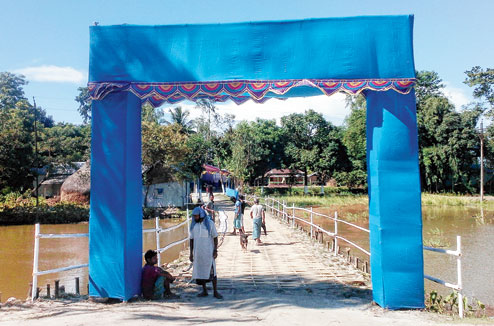
Dinhata :
The people of Mashaldanga built the road themselves with mud and covered it with bamboo cane. A big gate draped in blue cloth stands at the start of the road which leads to a colourful canopy.
The road did not cost much but the pandal did – Rs 2 lakh. Yet the people of Mashaldanga, the biggest Bangladeshi enclave in India, paid for it out of their pockets because on Friday this is where they will celebrate their coming into being.
On July 31 midnight, as Bangladesh and India exchange territories, the borders of the enclaves will dissolve.
It will mean that Mashaldanga and 50 other Bangladeshi enclaves in India will become Indian territory. Similarly the 111 Indian enclaves in Bangladesh will become Bangladesh territory.
For the people of Mashaldanga it will mean having a country in the real sense for the first time in their lives.
For 67 years since Independence, the people in the enclaves have been overlooked by both the countries. They have been denied everything that a state can give its citizens, starting with identity.
From Saturday morning, for the first time 14,000 people on the Indian side and 41,000 people in Bangladesh will become citizens of the respective countries.
Enclave residents were given a chance to choose their country. No one from the Indian side – the Bangladeshi enclaves are mostly in Cooch Behar and a few in Jalpaiguri – is crossing over.
In total, 979 people are coming over from the four districts in Bangladesh with enclaves – Kurigram, Lalmanirhat, Nilkhamari and Panchagarh – said the superintendent of police of Kurigram, Mahammad Tabarukullah.
Mashaldanga illustrates perfectly what being denied a country is like.
Through the middle of the green fields of Madhya Mashaldanga, the part of the enclave where the celebrations are being held, run electricity lines.
Yet no house in Madhya Mashaldanga has electricity because it is in Bangladesh.
Through the middle of Mashaldanga runs a road, but not many step on it, because it leads into the outer world – India.
Only one house in Madhya Mashaldanga has electricity, because that house is in an Indian enclave within the Bangladeshi enclave.
This enclave, with its only house, since it is Indian territory, has electric lines reaching it, resting on a row of poles that cut through the green fields.
What applies to electricity also applies to jobs. No Mashaldanga resident has ever had one.
If the children go to school in Mashaldanga, they need to cook up the name of a father as no father here has identity proof.
Jainal Abdedin, a 23-year-old from Madhya Mashaldanga, who was at the forefront of the movement to exchange enclaves, is a third-year political science honours student at Deoanhat College in Dinhata. Even if he became a graduate, he would not be able to get a job, because he would need more identity proof than required so far.
He has been able to go through school and college using the name of another person, an Indian citizen, as his father. Because his father, like all other residents of Mashaldanga, has no papers.
“Mithye bolte bolte obhyesh hoye gechhe (I have got used to telling lies),” he says.
But may be that would change now. With him becoming an Indian citizen, he can think of having a job.
The enclave exchange has been achieved, says Diptiman Sengupta, the man behind the Bharat Bangladesh Enclave Exchange Coordination Committee, because of the will of the people. The organisation has led the movement for the exchange and Jainal is a member of this organisation. Jainal, with his friend Saddam Mian, also look after the social media presence of the movement.
Sengupta points out that the history of enclaves began in the displacement of people. From the 1880s, when land began to be organised in India by the British and be marked, the landowners of the areas in which the enclaves – chhitmahal in Bengali – lie, began to gift each other mauzas as stakes in card or chess games.
But that was undivided India, and the stakes got scattered over what would come up as borders between first, India and Pakistan, and then Bangladesh.
After Independence, depending on the ownership, these plots remained Indian land in Pakistan/Bangladesh or Pakistani/Bangladeshi land in India.
And all the countries forgot them, though there were agreements from time to time.
The first one was between Jawaharlal Nehru and Feroze Khan Noon, the Indian and Pakistani Prime Ministers in 1958. In 1947, the Land Boundary Agreement was signed by Indira Gandhi and Sheikh Mujibur Rahman. Many governments and working groups and decades later, Indian Prime Minister Narendra Modi ratified the agreement on June 6, 2015, during his visit to Bangladesh.
“The government moved aggressively when it felt the will of the people,” says Sengupta. He thinks the exchange is a triumphant example of a history-making event that political parties could not interrupt.
The Indian authorities are making arrangements to receive the people from Balngladesh, who are expected after November 30.
Tota Mian, a Mashaldanga resident in his seventies, said today: ” Akhon swadhinata pailam (We have got independence, finally).”
source: http://www.telegraphindia.com / The Telegraph, Calcutta,India / Front Page> North Bengal> Story / by Chandrima S. Bhattacharya and Main Uddin Chisti / Friday – July 31st, 2015